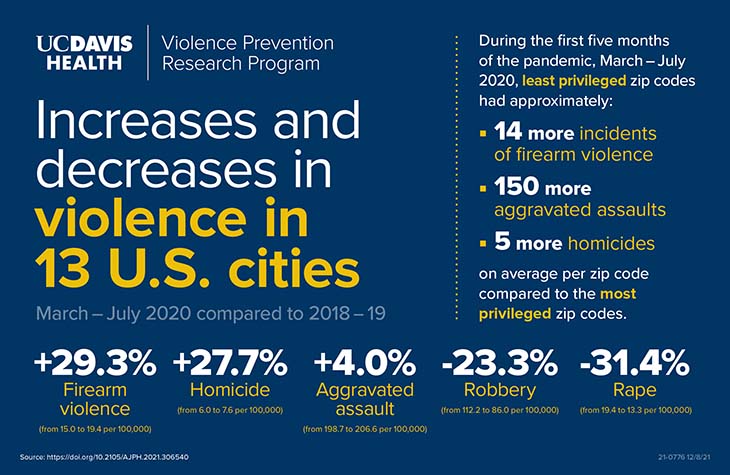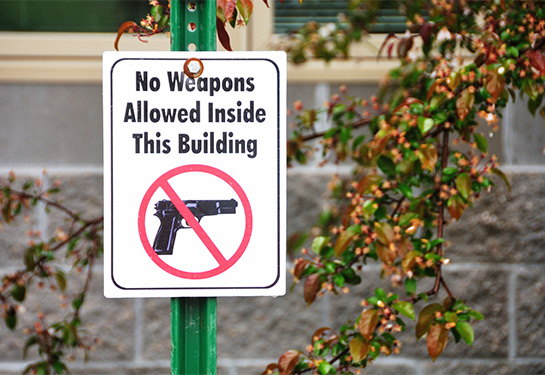Violence increased most in marginalized neighborhoods early in the COVID-19 pandemic
New UC Davis study tracks firearm violence, assault and homicide in 13 major U.S. cities by zip code
During the first five months of the pandemic in 2020, low-income communities of color experienced significantly greater increases in firearm violence, homicides and assaults compared to more affluent, white neighborhoods. Those are the findings of a new study from the Violence Prevention Research Program (VPRP) at UC Davis.
The research was published in the American Journal of Public Health.
Previous studies showed increases in violence in U.S. cities during the pandemic but did not indicate where violence was highest or increased most within those cities.
To determine which neighborhoods were most impacted, the researchers at VPRP tracked violence in 13 major cities in the United States: Baltimore, Boston, Chicago, Cincinnati, Dallas, Denver, Detroit, Los Angeles, Milwaukee, Philadelphia, Phoenix, San Francisco and Seattle.
The researchers used zip code-level data on firearm violence, homicide, assault, robbery and rape from 2018 to 2020. That allowed them to compare violence during the first five months of the pandemic to the same period in previous years.
Overall, they found firearm violence increased 29.3%, homicide by 27.7%, and assault by 4% in 2020 compared to 2018-2019.
When they compared the violence data with the racial and income composition of people in those same zip codes, the researchers found stark disparities.
“We found that zip codes with higher concentrations of low-income Black people and people of color experienced substantially higher rates of violence from March to July 2020 than did zip codes with higher concentrations of high-income white people,” said Julia Schleimer, the lead author of the study and a research data analyst at VPRP.
“We estimated that, in 2020, on average, there were approximately 14 more incidents of firearm violence in the least-privileged zip codes compared to the most privileged zip codes, and almost 150 more aggravated assaults and five more homicides,” said Schleimer.
The excess burden of violence in less- versus more-privileged neighborhoods was greater during the pandemic than in prior years.
But not all violent crime increased — robbery decreased 23.3% and rape by 31.4% overall during the first five months of the pandemic.
“The overall decline in robbery and rape may be real, or it may be an artifact of changes in reporting. For example, shelter-in-place orders may have reduced stranger rape or limited victims’ ability or willingness to report intimate partner rape. Research is needed to understand the drivers of these trends,” said Schleimer.

Methods
The researchers used zip-code level data from American Community Survey to measure racial and economic segregation. They identified neighborhoods ranging from least-privileged to most-privileged, recognizing that socially constructed class- and race-based hierarchies contribute to inequities in violence risk. More privileged areas were those with more households that earned more than $100,000 per year and more white people. Less-privileged zip codes were those with more households that earned less than $25,000 per year and more Black people and other people of color.
This study adds to the mounting body of research showing that equal opportunities — including the opportunity to live, work, learn, play, and worship free from violence — are not afforded to all.—Shani Buggs
“The least-privileged zip codes reflect a legacy of structural violence and decades-old discriminatory policies, like redlining,” said Schleimer.
Neighborhoods that were “redlined,” a federal discriminatory housing practice begun in the 1930s that disenfranchised Black and immigrant communities by significantly limiting housing opportunities, continue to experience higher rates of firearm violence today than neighborhoods deemed most desirable.
“This study adds to the mounting body of research showing that equal opportunities — including the opportunity to live, work, learn, play, and worship free from violence — are not afforded to all Americans and that the greatest burdens of violence are shouldered by our most marginalized and economically vulnerable neighborhoods,” said Shani Buggs, an assistant professor with the VPRP and co-author of the study.
“The pandemic has only worsened these outcomes. We must specifically and significantly increase investments in the development, empowerment and healing of the communities most affected,” said Buggs.
Additional authors on this study include Chris McCort, Veronica Pear, Alaina De Biasi, Elizabeth Tomsich, Aaron Shev, Hannah Laqueur and Garen Wintemute from VPRP.
Work for this study was supported by The Joyce Foundation (grant no. 42400), the Heising-Simons Foundation (grant no. 2019-1728), and the California Firearm Violence Research Center.
Research from the Violence Prevention Research Program
- Surge in firearm purchasing during pandemic’s onset linked to higher rates of firearm violence in U.S.
- U.S. saw surge in firearm purchases and violence during first months of COVID-19 pandemic
- Exposure to violence takes a toll on the socioemotional well-being of Californians
- Concerns about violence increase in California amid COVID-19 pandemic
The UC Davis Violence Prevention Research Program (VPRP) is a multi-disciplinary program of research and policy development focused on the causes, consequences and prevention of violence. Studies assess firearm violence, the social conditions that underlie violence, and the connections between violence, substance abuse and mental illness. VPRP is home to the University of California Firearm Violence Research Center, which launched in 2017 with a $5 million appropriation from the state of California to conduct leading-edge research on firearm violence and its prevention. For more information, visit health.ucdavis.edu/vprp/.





